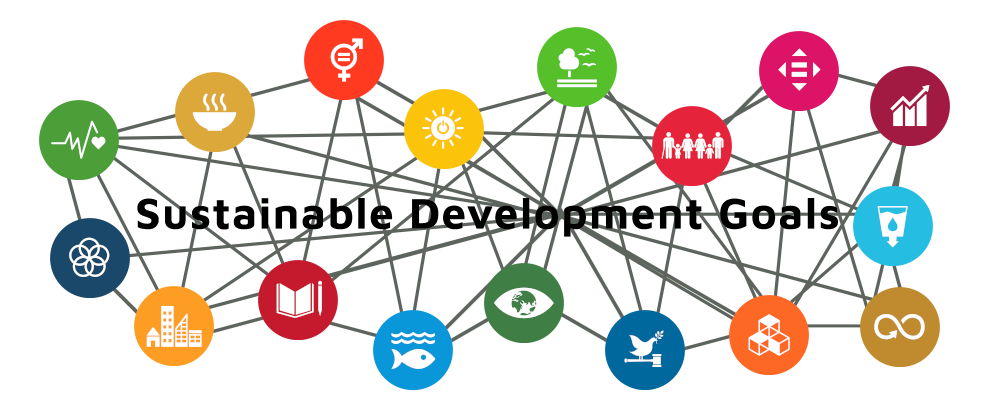Sustainable Development Goals
In this section you will find a brief summary of all 17 Sustainable Development Goals (SDGs). For more details, background information and additional material, please visit the United Nations website: https://sdgs.un.org/


![]() SDG 1: No Poverty
SDG 1: No Poverty
![]()
The first Sustainable Development Goal aims to “End poverty in all its forms everywhere”. Its seven associated targets aims, among others, to eradicate extreme poverty for all people everywhere, reduce at least by half the proportion of men, women and children of all ages living in poverty, and implement nationally appropriate social protection systems and measures for all, including floors, and by 2030 achieve substantial coverage of the poor and the vulnerable
As recalled by the foreword of the 2015 Millennium Development Goals Report, at the Millennium Summit in September 2000, 189 countries unanimously adopted the Millennium Declaration, pledging to “spare no effort to free our fellow men, women and children from the abject and dehumanizing conditions of extreme poverty”. This commitment was translated into an inspiring framework of eight goals and, then, into wide-ranging practical steps that have enabled people across the world to improve their lives and their future prospects. The MDGs helped to lift more than one billion people out of extreme poverty, to make inroads against hunger, to enable more girls to attend school than ever before and to protect our planet.
Nevertheless, in spite of all the remarkable gains, inequalities have persisted and progress has been uneven. Therefore, the 2030 Agenda for Sustainable Development and its set of Sustainable Development Goals have been committed, as stated in the Declaration of the Agenda, “to build upon the achievements of the Millennium Development Goals and seek to address their unfinished business”.
The theme of the 2017 High-Level Political Forum was “Eradicating poverty and promoting prosperity in a changing worl”“, and it included SDG 1 as one of the focus SDGs.

![]() SDG 2: Zero Hunger
SDG 2: Zero Hunger
![]()
Between 2014 and the onset of the pandemic, the number of people going hungry and suffering from food insecurity had been gradually rising. The COVID-19 crisis has pushed those rising rates even higher. The war in Ukraine is further disrupting global food supply chains and creating the biggest global food crisis since the Second World War. The COVID-19 crisis has also exacerbated all forms of malnutrition, particularly in children.
In 2020, between 720 and 811 million persons worldwide were suffering from hunger, as many as 161 million more than in 2019. Also in 2020, over 30 per cent – a staggering 2.4 billion people – were moderately or severely food-insecure, lacking regular access to adequate food. This represents an increase of almost 320 million people in the course of just one year.
Globally, 149.2 million children under five years of age, or 22.0 per cent, were suffering from stunting (low height for age) in 20202, the proportion having decreased from 24.4 per cent in 2015. These numbers may become higher, however, owing to continued constraints on accessing nutritious diets and essential nutrition services during the pandemic, with the full impact possibly taking years to manifest itself. To achieve the target of a 5 per cent reduction in the number of stunted children by 2025, the current rate of decline of 2.1 per cent per year must double through global efforts to 3.9 per cent per year.
In 20202, wasting (low weight for height) affected 45.4 million children under five years of age (6.7 per cent) and overweeight affected 38.9 million children under five years of age (5.7 per cent). Wasting will be one of the conditions most impacted by COVID-19 pandemic in the short term; about 15 per cent more children than currently estimated may have been suffering from wasting, owing to deterioration in household wealth and disruptions in the availability and affordability of nutritious food and essential nutrition services. Childhood overweight may also be on the rise in some countries where unhealthy food replaced fresh, nutritious food and movement restrictions have constrained opportunities for physical activity for long periods of time.
In women, anaemia increases the risk of adverse maternal and neonatal outcomes. Since 2015, the prevalence of anaemia in women of reproductive age has been stagnant globally, with over half a billion women aged 15-49 years with anaemia in 2019, representing a prevalence of 29.9 per cent (29.6 per cent in non-pregnant women and 36.5 per cent in pregnant women).
.

![]() SDG 3: Good Health and Well-being
SDG 3: Good Health and Well-being
![]()
By April 2022, the coronavirus causing COVID-19 had infected more than 500 million people and killed more than 6.2 million worldwide. However, the most recent estimates suggest that the global number of excess deaths directly and indirectly attributable to COVID-19 could be as high as three times this figure. The pandemic has severely disrupted essential health services, shortened life expectancy and exacerbated inequities in access to basic health services between countries and people, threatening to undo years of progress in some health areas. Furthermore, immunization coverage dropped for the first time in 10 years and deaths from tuberculosis and malaria increased.
Reproductive, maternal and child health
Based on data from 2015-2021, 84 per cent of births worldwide were assisted by skilled health professionals, including medical doctors, nurses and midwives, an increase from 77% in 2008-2014. In sub-Saharan Africa, coverage is 20 percentage points lower. Available data do not reflect the impact of the COVID-19 pandemic on the disruption of services, which may reverse gains made over the past decades.
The global under-5 mortality rate fell by 14 per cent, from 43 deaths per 1,000 live births in 2015 to 37 deaths per 1,000 live births in 2020, while the global neonatal mortality rate fell to 17 deaths per 1,000 live births in 2020 from 19 deaths per 1,000 live births in 2015, a 12 per cent reduction. Even with that progress, 5 million children died before reaching their fifth birthday in 2020 alone, down from 5.9 million in 2015. Almost half of those deaths, 2.4 million, occurred in the first month of life.
The proportion of women of reproductive age (15-49 years) whose need for family planning was satisfied through use of modern contraceptive methods stagnated at about 77 per cent between 2015 and 2022, while sub-Saharan Africa has seen the largest increase – almost 5 percentage points. The ongoing COVID-19 pandemic may lead to a reversal of this trend because of supply chain disruptions and decreased access to family planning services.
The adolescent birth rate has fallen worldwide from 56 births per 1,000 adolescents aged 15-19 years in 2000 to 45 births in 2015 and 41 births in 2020. The largest declines are occurring in Central and Southern Asia, from 70 births per 1,000 adolescent women in 2000 to 24 births in 2020. Early adolescent childbearing, occuring in the 10–14 age group, is much more common in countries in sub-Saharan Africa and Latin America and the Caribbean than in other parts of the world.
.

![]() SDG 4: Quality Education
SDG 4: Quality Education
![]()
The COVID-19 outbreak has caused a global education crisis. Most education systems in the world have been severely affected by education disruptions and have faced unprecedented challenges. School closures brought on by the pandemic have had devastating consequences for children’s learning and well-being. It is estimated that 147 million children missed more than half of their in-class instruction over the past two years. This generation of children could lose a combined total of $17 trillion in lifetime earnings in present value. School closures have affected girls, children from disadvantaged backgrounds, those living in rural areas, children with disabilities and children from ethnic minorities more than their peers.
The proportion of young people completing upper secondary school increased from 54 per cent in 2015 to 58 per cent in 2020, with completion slowing down relative to progress in the preceding five-year period. It is too early to predict the effect of the COVID-19 pandemic on completion. Early indications from low-income countries based on phone surveys point to a small decline in attendance upon a return to school but a larger increase in repetition, which may increase dropout rates in coming years.
Data from 73 (mostly low- and middle-income) countries for the period of 2013-2021, indicate that about 7 in 10 children 3 and 4 years of age are developmentally on track, with no significant differences by child’s sex.
The participation rate in organized learning one year before the official primary entry age rose steadily in the years before the COVID-19 pandemic, from 69 per cent in 2010 to 75 per cent in 2020 but with considerable variation between countries (with the rate ranging from a figure as low as 13 per cent to nearly 100 per cent). This progress is being threatened by the COVID-19 pandemic, as schoolchildren in early childhood education and the early grades, especially from low- and middle-income countries, are the most affected by education disruption. In most countries, early education facilities and schools were partially or fully closed for more than a full school year.
Based on data for 2016-2018, the participation rate of youth and adults in formal and non-formal education and training in the previous 12 months among countries of sub-Saharan Africa with data is typically about 5 per cent or less compared with a rate of over 40 per cent in Northern American and many European countries….
.

![]() SDG 5: Gender Equality
SDG 5: Gender Equality
![]()
The world is not on track to achieve gender equality by 2030 and has been pushed further off track by the socioeconomic fallout of the pandemic. Women and girls remain disproportionately affected, struggling with lost jobs and livelihoods, derailed education, increased burdens of unpaid care work and domestic violence. Over 100 million women aged 25-54 years with small children at home were out of the workforce globally in 2020, including the more than 2 million who left the labour force owing to the increased pressures of unpaid care work. Women’s health services faced major disruptions and undermined women’s sexual and reproductive health. Moreover, despite women’s effective and inclusive leadership in responding to the COVID-19 pandemic, they are excluded from decision-making positions. Furthermore, many countries do not have comprehensive systems for tracking budgets for gender equality, limiting the allocation of public resources for implementation of laws and policies. Efforts must be strengthened to ensure that laws, policies, budgets and institutions advance gender equality.
Discriminatory laws and legal gaps continue to prevent women from enjoying their human rights. Based on 2020 data from 95 countries and territories, more than half lacked quotas for women in the national parliament; while 83 per cent included budgetary commitments to implement legislation addressing violence against women, 63 per cent continued to lack laws defining rape based on the principle of consent. Although over 90 per cent mandate non-discrimination based on gender in employment, almost half continued to restrict women from working in certain jobs or industries and almost one quarter of countries did not grant women equal rights with men to enter marriage and initiate divorce.
Violence against women and girls is prevalent across countries and affects women of all ages. In 2018, globally, over 1 in 4 (26 per cent) ever-partnered women aged 15 years or over, or a total of 641 million women, have been subjected to physical and/or sexual violence by a husband or intimate partner at least once in their lifetime. Data on violence experienced by older women, including on specific forms such as being restrained, being ostracized or neglected, are urgently needed but remain largely unavailable. Only less than 10 per cent of eligible data on intimate partner violence capture the prevalence of this form of violence against women aged 50 years or over.
One in five young women worldwide (19 per cent) were married in childhood in 2021. Child marriage is most common in sub-Saharan Africa, a region where progress has been modest, followed by South Asia, which has achieved greater declines. Globally, the prevalence of child marriage has declined by about 10 per cent in the past five years. However, the profound effects of the COVID-19 pandemic are threatening this progress, with up to 10 million additional girls at risk of child marriage in the next decade because of the pandemic.
The practice of female genital mutilation has proved remarkably tenacious, despite efforts spanning nearly a century to eliminate it. At least 200 million girls and women alive today have been subjected to female genital mutilation, based on the latest available data from 31 countries, where the practice is concentrated. Nevertheless, several countries have seen some declines in the practice compared with 30 years ago.
On an average day, women spend about 2.5 times as many hours on unpaid domestic work and care work as men, according to the latest data from 90 countries and areas collected between 2001 and 2019.
As at 1 January 2022, the global share of women in lower and single houses of national parliaments reached merely 26.2 per cent, up from 25.6 per cent in 2021. Women’s share is slight over one third in local governments (in 135 countries with data). Well-designed legislated gender quotas, zero tolerance for violence against women in politics and gender-sensitive and safer political environments are key to fast-tracking and sustaining women’s equal representation in decision-making…

![]() SDG 6: Clean Water and Sanitation
SDG 6: Clean Water and Sanitation
![]()
Access to safe water, sanitation and hygiene is the most basic human need for health and well-being. Billions of people will lack access to these basic services in 2030 unless progress quadruples. Demand for water is rising owing to rapid population growth, urbanization and increasing water needs from agriculture, industry, and energy sectors. Decades of misuse, poor management, overextraction of groundwater and contamination of freshwater supplies have exacerbated water stress. In addition, countries are facing growing challenges linked to degraded water-related ecosystems, water scarcity caused by climate change, underinvestment in water and sanitation and insufficient cooperation on transboundary waters.
Between 2015 and 2020, the population using safely managed drinking water services increased from 70 per cent to 74 per cent, the population with safely managed sanitation increased from 47 per cent to 54 per cent and the population with access to handwashing facilities with soap and water in the home increased from 67 per cent to 71 per cent. Rates of progress for these basic services would need to quadruple for universal coverage to be reached by 2030.
Assessment of rivers, lakes and aquifers in 97 countries in 2020 shows that 60 per cent of water bodies assessed have good water quality. Of the 76,000 water bodies that were reported on in 2020, only 1 per cent were from the poorest countries. For at least 3 billion people, the quality of the water they rely upon is unknown owing to a lack of monitoring.
Water use efficiency worldwide rose from $17.4 per cubic metre in 2015 to $19.4 per cubic metre in 2019, which represents a 12 per cent efficiency increase. Around 57 per cent of countries presented a water use efficiency equivalent to $20 per cubic metre or less in 2019.
Across the world, water stress levels remained safe at 18.6 per cent in 2019, although this hides large regional variations. Southern Asia and Central Asia registered high levels of water stress at over 75 per cent, whereas Northern Africa registered a critical water stress level of over 100 per cent. Since 2015, water stress levels have increased significantly in Western Asia and Northern Africa….
.

![]() SDG 7: Affordable and Clean Energy
SDG 7: Affordable and Clean Energy
![]()
Despite progress, there are still over 700 million people globally living in the dark and 2.4 billion cooking with harmful and polluting fuels. Although the use of renewable energy and energy efficiency have improved, progress is not fast enough to achieve Sustainable Development Goal 7. The war in Ukraine is driving up global energy prices and increasing energy insecurity in Europe. To respond to the energy crisis, some European countries plan to speed up the transition to renewables and increase investments in renewables and energy efficiency, while some other countries plan to bring about a resurgence of coal, putting the green transition at risk.
Between 2010 and 2020, the proportion of world population with access to electricity reached 91 per cent, up from 83 per cent, with 1.3 billion people gaining access. This still leaves 733 million people in the dark with more than three quarters of them living in sub-Saharan Africa. In the period 2018-2020, the annual access growth was 0.5 percentage points, which should accelerate to an annual average of 0.9 percentage points so that universal access can be achieved by 2030. This requires significant efforts to reach those living in low-income, fragile and conflict-affected countries.
In 2020, 69 per cent of the global population had access to clean cooking fuels and technologies. While more than half of those without access to clean cooking fuels live in Asia, 19 out of the 20 countries with the lowest percentage of people having access to clean cooking were least developed countries in Africa.
The share of renewable sources in total final energy consumption amounted to 17.7 per cent globally in 2019, which is less than one percentage point higher than the figure for 2015. The electricity sector records the largest share of renewables in total final energy consumption (26.2 per cent in 2019) and drives most of the growth in renewable energy use, while the heat and transport sectors have seen limited progress.
Global primary energy intensity—defined as global total energy supply per unit of GDP, improved from 5.6 megajoules per dollar (2017 purchasing power parity) in 2010 to 4.7 megajoules in 2019. Since 2015, global energy intensity has improved by 1.6 per cent per year on average, which is still short of the 3.2 per cent annual rate now needed to reach Sustainable Development Goal 7.3.
International financial flows to developing countries in support of clean and renewable energy reached $10.9 billion in 2019, 23.6 per cent lower than that in 2018 and representing a contraction even before the onset of the COVID-19 pandemic. A longer five-year moving average trend shows that average annual commitments decreased for the first time since 2008 by 5.5 per cent from $17.5 billion in 2014-18 to $16.6 billion in 2015-19…

![]() SDG 8: Decent Work and Economic Growth
SDG 8: Decent Work and Economic Growth
![]()
In 2020, the COVID-19 pandemic unleashed the worst economic crisis in decades, with a severely damaging impact on working time and income. Although the global economy started to rebound in 2021, waves of spreading COVID-19 infections together with rising inflation, major supply chain disruptions, policy uncertainties and unsustainable debt of developing countries caused the global economy to slow down at the end of 2021. The conflict in Ukraine is expected to seriously set back global economic growth in 2022.
Following an increase of about 1.4 per cent in 2019, global real GDP per capita decreased sharply by 4.4 per cent in 2020. Global real GDP per capita is estimated to have rebounded at a growth rate of 4.4 per cent in 2021 and is projected to increase again by 3.0 per cent in 2022 and 2.5 per cent in 2023 based on pre-war estimations. The war in Ukraine is likely to downgrade global growth. The real GDP of least developed countries had increased by 5.0 per cent in 2019 but showed no growth in 2020 because of the disruption caused by the pandemic.
The COVID-19 pandemic resulted in unprecedented, volatile developments in labour productivity levels. Globally, output per worker grew at an average annual rate of 1.6 per cent between 2015 and 2019. In 2020, the output per worker dropped by 0.6 per cent, the first such decline since 2009. Global labour productivity rebounded sharply in 2021, rising by 3.2 per cent. 86. Prior to the onset of the pandemic, informal employment represented 60.2 per cent of global employment in 2019. COVID-19 pandemic containment measures and mobility restrictions prevented labour reallocation to informal employment. Rather than become unemployed or shift to informal jobs, as in previous crises, laid -off employees and self-employed workers alike left the labour force. A disproportionate impact on informal workers was reflected in a decline in the informal employment rate in some countries at the height of the crisis, which has left informal workers and their families in a highly precarious position, exposed to sudden income losses and heightened risks of falling into poverty.
Equal treatment in employment is part and parcel of decent work. Globally women continue to be paid 19 per cent less than men according to an International Labour Organization (ILO) 2018/2019 study. In 87 per cent of countries with recent data, professionals earn per hour on average more than double what workers in elementary occupations earn.
In 2021, the global unemployment rate declined slightly to 6.2 per cent, which is still well above the pre-pandemic rate of 5.4 per cent. ILO projects that unemployment will remain above its 2019 level until at least 2023. Meanwhile, the level of unemployment underestimates the full employment impact of the crisis since many who left the labour force have not come back nor does it reflect the reduction in working hours for those who remained employed. In 2021, 4.3 per cent of global working hours were lost compared with the fourth quarter of 2019, which is equivalent to a deficit of 125 million full-time jobs (assuming a 48‑hour working week).
The proportion of the world’s youth not in education, employment or training (NEET) is now at its highest level since 2005. The NEET rate had remained unchanged from 2015 to 2019 at 21.8 per cent but increased to 23.3 per cent in 2020, representing an addition of almost 20 million youth. Although youth represented only 13 per cent of total employment before the crisis, they made up 34.2 per cent of the 2020 decline in employment. Meanwhile, both technical and vocational education and on-the-job training suffered massive disruption, forcing many young people to quit their studies.
Latest estimates indicate that the number of children in child labour rose to 160 million (63 million girls and 97 million boys) worldwide at the beginning of 2020, representing an increase of 8.4 million children in the last four years and translating into almost 1 in 10 of all children in child labour worldwide.
Global GDP from tourism nearly halved between 2019 and 2020 and the sector faced its worst crisis in recent history, with businesses, employment and livelihoods around the world severely impacted. After a marked positive trend over the past decade and reaching $3.4 trillion in 2019 or 4 per cent of global GDP, the economic contribution of tourism plummeted to $1.8 trillion or 2.3 per cent of world GDP in 2020….

![]() SDG 9: Industry, Innovation and Infrastructure
SDG 9: Industry, Innovation and Infrastructure
![]()
The manufacturing industry exhibited a recovery from the pandemic in 2021, although the rebound has been uneven across countries, with stagnations in least developed countries. Almost one in three jobs in the manufacturing industry were negatively impacted during the pandemic. Higher-technology industries had a better performance and recovered faster, providing a strong example of how important technological innovation is for achieving Sustainable Development Goal 9.
In 2021, global manufacturing activity rose above the pre-pandemic level but the recovery remains incomplete and unequal. Manufacturing in least developed countries stagnated owing to subdued and volatile global demand and disruption to global trade, in addition to tighter domestic economic policies. Despite the pandemic disruptions, the global share of manufacturing value added in total GDP increased from 16.2 per cent in 2015 to 16.9 per cent in 2021. While manufacturing value added per capita in Europe and Northern America reached an all-time high of $5,006 in 2021, in least developed countries it decreased to $134.
Because of the pandemic, nearly one in three jobs in manufacturing supply chains globally are likely to have undergone termination, a reduction in working hours or payment or other worsened conditions. The share of manufacturing employment in total employment thus decreased significantly from 13.7 per cent in 2019 to 13.1 per cent in 2020.
Small industrial enterprises are more vulnerable than larger firms to economic downturns owing to their limited financial resources and greater supply chain dependencies. Although governmental support plays a key role in supporting small enterprises in their efforts to survive and thrive during and after the crisis, such a stimulus is hardly available in low-income countries. Based on survey data from 2006–2020, only 15.7 per cent of small-scale industries in sub-Saharan Africa received loans or lines of credit compared with 44.2 per cent in Latin America and the Caribbean.
Global CO2 emissions declined by 5.8 per cent in 2020 or by almost 2 billion tons, the largest decline since 1990 and almost five times greater than the 2009 decline which followed the global financial crisis. Despite the 2020 decline, global energy-related CO2 emissions remained at 31.5 billion tons, which contributed to the attainment by CO2 of its highest average annual concentration in the atmosphere. In 2021, global energy-related CO2 emissions rose by 6.0 per cent to 36.3 billion metric tons, their highest ever level, as demand for coal, oil and gas rebounded with the economy.
Most of the industries using medium and high technology have reached pre-pandemic levels, except for motor vehicles and other transport equipment. The production of motor vehicles is facing larger challenges worldwide owing to disruptions of the supply chain for resources and intermediate goods. However, the share of medium- and high-technology manufacturing in total manufacturing was only 21.4 per cent in sub-Saharan Africa and 10.5 per cent in least developed countries, compared with 47.7 per cent in Europe and Northern America in 2019….

![]() SDG 10: Gender Equality
SDG 10: Gender Equality

The COVID-19 crisis has exacerbated global income inequality, partly reversing the decline of the previous two decades. Weak recoveries in emerging markets and developing economies are expected to raise between-country inequality. Globally, the absolute number of refugees in 2021 was the highest on record. The war in Ukraine is creating one of the largest refugee crises of modern times.
Prior to the outbreak of the COVID-19 pandemic, more than three fifths of countries with available data saw higher growth in household expenditure or income per capita among the bottom 40 per cent of the population than the national average. The pandemic is threatening to reverse this trend. In 2020 many countries saw declines in growth among the bottom 40 per cent of greater magnitude than the national average.
Banks’ profitability weakened in 2020 mostly because of the COVID-19 pandemic, although reported asset quality remained good. Based on financial soundness indicators data for 2015–2020, the fraction of countries reporting return on assets above 1.0 per cent declined to 48 per cent in 2020 from 72 per cent in 2019 and the median return on assets declined from 1.5 per cent to 1.0 per cent.
The International Organization for Migration Missing Migrants Project recorded 5,895 deaths on migratory routes worldwide in 2021, a number surpassing pre-pandemic figures and making 2021 the deadliest year on record for migrants since 2017.
By mid-2021, the number of people who were forced to flee their countries owing to war, conflict, persecution, human rights violations or events causing serious disturbances of public order had grown to 24.5 million, the highest absolute number on record. For every 100,000 people, 311 are refugees outside their country of origin, an increase from 216 in 2015. In addition, as at 12 April 2022, about 4.7 million refugees from Ukraine had crossed borders into neighbouring countries.
Globally, in 2021, 62.3 per cent of 138 countries with data reported having a wide range of policies to facilitate orderly, safe, regular and responsible migration and mobility of people, meaning that they had policy measures for 80 per cent or more of the 30 subcategories under the six domains of the indicator.
The proportions of tariff lines applied to imports admitted duty-free from least developed countries, small island developing States and developing countries have remained relatively stable in recent years, at around 64.5 per cent, 65 per cent and 51 per cent, respectively….

![]() SDG 11: Sustainable Cities and Communities
SDG 11: Sustainable Cities and Communities
![]()
As epicentres of the COVID-19 crisis, many cities have suffered from insufficiencies in public health systems, inadequate basic services, a lack of well-developed and integrated public transport systems and inadequate open public spaces, as well as from the economic consequences of lockdowns. As a result, the pandemic is likely to further increase the number of slum dwellers. In order to improve the lives of over 1 billion slum dwellers, there is an urgent need to focus on policies for improving health, affordable housing, basic services, sustainable mobility and connectivity.
Over the years, the number of slum dwellers has continued to grow and that number was over 1 billion in 2020. Slum dwellers are most prevalent in three regions, which are home to about 85 per cent of the world’s slum residents: Central and Southern Asia (359 million), Eastern and South-Eastern Asia (306 million) and sub-Saharan Africa (230 million).
Data for 2020 from 1,510 cities around the world indicate that on average only about 37 per cent of their urban areas are served by public transport, measured as a walking distance of 500 m to low-capacity transport systems (such as buses and trams) and/or 1,000 m to high-capacity systems (such as trains and ferries). Given variations in population concentrations within those cities, this translates into only about 52 per cent of the world population having convenient access to public transport.
In 2022, the global average municipal solid waste collection rate in cities is at 82 per cent and the global average rate of municipal solid waste management in controlled facilities in cities is at 55 per cent. The municipal solid waste collection rates in sub-Saharan Africa and Oceania are less than 60 per cent. Uncollected waste is the source of plastic pollution, greenhouse gas emissions and incubation for infections.
Data for 2020 from 1,072 cities point to a poor distribution of open public spaces in most regions. In these cities, only about 38 per cent of urban areas are loca ted within a walking distance of 400 m to an open public space, which translates into only about 45 per cent of the global urban population having convenient access to those spaces.
By March 2021, a total of 156 countries had developed national urban policies, with almost half (74) already in the implementation stage. A further breakdown shows that 40 per cent of the countries are in the early stages of developing their plans, while 12 per cent are monitoring and evaluating how well those plans are functioning.
By the end of 2021, a total of 98 countries had reported having local governments with disaster risk reduction strategies, an increase from 51 countries in 2015….

![]() SDG 12: Responsible Consumption and Production
SDG 12: Responsible Consumption and Production
![]()
Developing countries bear a large part of the climate, biodiversity and pollution impacts of resource-intensive production processes, without reaping their benefits. This situation has been made worse by the impacts of the pandemic. As part of sustainable global pandemic recovery strategies, the implementation of sustainable consumption and production will maximize the socioeconomic benefits of resource use while minimizing the impacts.
In 2021, 83 policy instruments supporting the shift to sustainable consumption and production were reported by 26 countries, bringing the total number of policies developed, adopted and/or implemented up to 438 (as reported by 59 countries and the European Union for 2019–2021). However, the distribution of reported sustainable consumption and production policies has so far been uneven, with 79 per cent of policies reported by high-income and upper middle income countries, 0.5 per cent by low-income countries and only 7.7 per cent by least developed countries, landlocked developing countries and small island developing States.
The global material footprint continues to grow, although the pace has slowed. The average annual growth rate of the global material footprint for 2015–2019 was 1.1 per cent, compared with 2.8 per cent for 2000–2014, indicating a slowdown in the growth of economic pressure on the environment.
The proportion of food lost globally after harvest on farm, transport, storage, wholesale and processing levels is estimated at 13.3 per cent in 2020, with no visible trend since 2016, suggesting that structural patterns of food losses have not changed. At the regional level, sub-Saharan Africa has the highest proportion of losses at 21.4 per cent, with food being lost in large quantities between the farm and retail levels.
In addition to food loss, it is estimated that 931 million tons of food, or 17 per cent of total food available to consumers in 2019, was wasted at the household, food service and retail levels. Subsequent evidence suggests that household food waste declined during the COVID-19 pandemic lockdowns but has since returned to pre-pandemic levels.
The COVID-19 pandemic aggravated the global pollution crisis, in particular plastics pollution, making the effective implementation of the Basel Convention on the Control of Transboundary Movements of Hazardous Wastes and Their Disposal, the Rotterdam Convention on the Prior Informed Consent Procedure for Certain Hazardous Chemicals and Pesticides in International Trade and the Stockholm Convention on Persistent Organic Pollutants so much more urgent and important. The year 2021 was marked by the establishment of a new global regime for controlling trade of plastic wastes for better transparency and tracing, following the adoption of the plastic waste amendments to the Basel Convention in 2019.
A preliminary analysis from a sample of over 10,000 public companies around the world shows that over 60 per cent of large companies published sustainability reports in 2021, a twofold increase from 2016. The sustainability indicators that are most widely disclosed by companies include direct CO2 emissions, board diversity E/2022/55 22-06472 19/25 and number of board meetings, while the least disclosed indicators include ozone depleting substances, gender pay gap and bribery and fraud controversies….

![]() SDG 13: Climate Action
SDG 13: Climate Action
![]()
The increases in heatwaves, droughts and floods caused by climate change are destroying the planet and affecting billions of lives worldwide. Despite the temporary reduction of CO2 emissions in 2020, global energy-related CO2 emissions rose by 6.0 per cent as demand for coal, oil and gas rebounded with the economy in 2021. Based on current national commitments, global emissions are set to increase by almost 14 per cent over the current decade, which could lead to a climate catastrophe unless Governments, the private sector and civil society work together to take immediate action. However, the war in Ukraine threatens to become the cause of a huge setback for concerted efforts to speed up climate action.
As at 31 December 2021, a total of 123 countries had reported the adoption of national disaster risk reduction strategies, an increase from 55 countries in 2015. The number of countries with disaster risk reduction strategies that promote policy coherence with the Sustainable Development Goals and the Paris Agreement has reached 118, compared with only 44 in 2015. The COVID-19 crisis highlighted a further accelerated global effort and an approach to disaster risk reduction strategies that is more systemic and more multi-hazard in nature.
By April 2022, 193 parties (192 countries plus the European Union) had communicated their first nationally determined contribution under the United Nations Framework Convention on Climate Change and 13 parties had submitted their second nationally determined contribution. The nationally determined contributions attest that countries are articulating more quantified targets and indicators for adaptation and identifying links between adaptation and the Sustainable Development Goals and other frameworks.
As at 31 March 2021, 125 of 154 developing countries were taking measures related to national adaptation plans and prioritizing formulation and implementation of national adaptation plans in their adaptation efforts. Six of the least developed countries (including three small island developing States) and an additional four small island developing States had completed a national adaptation plan. More of the least developed countries had prepared a draft national adaptation plan and were on track to complete and submit it in line with the vision of all least developed countries having their national adaptation plan by 2021.
In order to limit global warming to 1.5 degrees Celsius above pre-industrial levels, scientists recommend that by 2030 global emissions should be cut by 4 per cent compared with 2010 levels. According to current national commitments, however, global emissions are set to increase by almost 14 per cent during the rest of the decade….

![]() SDG 14: Life Below Water
SDG 14: Life Below Water
![]()
The world’s oceans and seas continue to struggle against increased acidification, eutrophication and plastic pollution, which are endangering the planet’s largest ecosystem and the billions of livelihoods depending on them. The pandemic has not eased that burden, as an estimated 25,000 tons of plastic waste has steadily entered the global ocean owing to an increase in single-use plastic primarily from medical waste. Owing to the initial lockdowns arising from the COVID-19 pandemic, most countries experienced a 40–80 per cent decline in fish production, with small-scale fisher communities hardest hit. The pandemic also led to a dramatic reduction in tourism, causing substantial income losses for coastal and island communities.
The satellite-derived eutrophication indicator shows an increasing trend from 2016 to the present. While the COVID-19 pandemic may have caused some reduction in coastal pollution in certain areas owing to reduced tourism and activity, the pandemic does not appear to have globally reduced eutrophication. In fact, there was an increase of over 23 per cent in the peak values of the indicator for the 2020 and 2021 calendar year average, compared with the mean value for previous years.
Ocean acidification is the consequence of uptake of atmospheric CO2 by the ocean, resulting in a decreasing pH level and increasing acidification of the ocean, thereby negatively affecting marine organisms and ocean services. Data collected from 308 stations of 35 countries in 2022 highlight the growing capacity of countries to observe the continued decline of ocean pH in the global ocean as well as the strong regional differences in the pace of change.
Between 2018 and 2022, the average degree of implementation of international instruments to combat illegal, unreported and unregulated fishing as measured by the indicator has improved across the world. In this period, the global aggregated indicator has risen from 3 to 4 (out of a maximum score of 5). Countries have thus made good overall progress with close to 75 per cent scoring high in their degree of implementation of relevant international instruments in 2022 compared with 70 per cent in 2018.
In the International Year of Artisanal Fisheries and Aquaculture 2022, the level of adoption of regulatory frameworks supporting small-scale fisheries and promoting participatory decision-making has improved worldwide. The average global score has risen to 5 out of 5 in 2022, up from 4 out of 5 in 2020 and 3 out of 5 in 2018.
Overall, many States have ratified or acceded to the 1982 United Nations Convention on the Law of the Sea (168 parties) and its implementing agreements (Agreement relating to the Implementation of Part XI of the United Nations Convention on the Law of the Sea of 10 December 1982: 151 parties; and Agreement for the Implementation of the Provisions of the United Nations Convention on the Law of the Sea of 10 December 1982 relating to the Conservation and Management of Straddling Fish Stocks and Highly Migratory Fish Stocks: 91 parties). While many States have implemented those instruments through legal, policy and institutional frameworks, this remains an area for further progress in several developing countries, in particular least developed countries….

![]() SDG 15: Life On Land
SDG 15: Life On Land
![]()
Continued global deforestation, land and ecosystem degradation, and biodiversity loss pose major risks to human survival and sustainable development. Even as efforts are made in the domain of sustainable forest and natural resource management, commitments and instruments designed to protect, restore and sustainably use forests and biodiversity need to be urgently implemented to ensure healthy, resilient societies.
The world’s forest area continues to decrease but at a slightly slower rate compared with previous decades. The proportion of forest area fell from 31.9 per cent of total land area in 2000 to 31.2 per cent of total land area in 2020. Despite the overall loss of forest, the world continues to progress towards sustainable forest management. Between 2010 and 2020, the share of forests under certification schemes, the proportion of forest within a protected area and the proportion of forests under a long-term management plan increased globally.
Safeguarding key biodiversity areas through the establishment of protected areas or other effective area-based conservation is an essential contribution towards Sustainable Development Goals 14 and 15. Globally, this coverage of marine, terrestrial, freshwater, and mountain key biodiversity areas has increased from about one quarter of each site on average covered by protected areas 20 years ago to nearly half of each site covered in 2021.
Vegetation coverage of the world’s mountains remains roughly stable at approximately 73 per cent since 2015. Disaggregated data by mountain class shows that green cover tends to decrease with mountain elevation, evidencing the strong role of climate in mountain green cover patterns.
By February 2022, 129 countries had committed to setting their voluntary targets for achieving land degradation neutrality, and in 71 countries, Governments had already officially endorsed those targets. Overall, commitments to land restoration are estimated at 1 billion ha, out of which over 450 million ha are committed through land degradation neutrality targets.
The Red List Index shows continuing deterioration in terms of species extinction risk around the world, based on repeated assessments of the extinction risk of all amphibians, birds, mammals, corals and cycads, representing about 25,000 species in total. The index went from 0.80 in 2000 to 0.72 in 2022. The prevalence and rate of extinction risk are particularly severe in Central and Southern Asia, Eastern and South-Eastern Asia and small island developing States. COVID-19 pandemic impacts on species extinction risk are likely negative mainly because of reduced conservation capacity and resources, along with increased threats.
At the end of 2021, 68 countries had at least one legislative, administrative or policy measure in place to ensure the fair and equitable sharing of benefits arising from the use of genetic resources and associated traditional knowledge in accordance with the Nagoya Protocol on Access to Genetic Resources and the Fair and Equitable Sharing of Benefits Arising from Their Utilization to the Convention on Biological Diversity. Furthermore, 79 countries reported measures in place to implement the International Treaty on Plant Genetic Resources for Food and Agriculture…

![]() SDG 16: Pease, Justice and strong Institutions
SDG 16: Pease, Justice and strong Institutions
![]()
Pleas for global peace are growing louder as the world witnesses the highest number of violent conflicts since 1945, with approximately 2 billion people living in conflict-affected countries by the end of 2020. Amid these crises and despite movement restrictions arising from the COVID-19 pandemic, forced displacement has continued to occur and even grow. By the end of 2020, 82.4 million people had been forcibly displaced worldwide, which means that 1 in 95 persons has currently been forcibly displaced. These numbers will increase, as the war in Ukraine is estimated to have already displaced over 7 million people in the country. The costs of war and conflict are high, affecting the poorest and most vulnerable the most and leading to global impacts and escalating humanitarian needs.
Globally, about 437,000 people were victims of homicide in 2020. Between 2015 and 2020, the global homicide rate declined by 5.2 per cent (from 5.9 homicides per 100,000 population to 5.6 per 100,000). Women and girls are disproportionately impacted by lethal violence in the home and account for about 60 per cent of all homicide victims killed by intimate partners or other family members.
The United Nations recorded at least 11,075 civilian conflict-related deaths in 12 of the world’s deadliest armed conflicts in 2021. This translates into 4.1 civilians per 100,000 population; one in eight of those deaths was the death of a woman or child. Compared with 2020, the number of deaths decreased by 26 per cent and by 80 per cent compared with 2015. Despite the overall reduction, many of these situations are fragile, with ongoing and growing risks of escalation and associated violations of international human rights and international humanitarian law. As at 12 April 2022, the Office of the United Nations High Commissioner for Human Rights had recorded the killing of 1,932 civilians in the conflict in Ukraine and the actual figure is considerably higher.
Based on survey data from 114 countries, on average, approximately 69 per cent of the population report feeling safe or very safe walking alone around the area in which E/2022/55 22-06472 23/25 they live after dark, a figure that has remained stable over the period 2016–2021. Women continue to feel significantly less safe than men.
Violence against children is widespread, affecting children regardless of wealth or social status. In 76 countries (mostly low- and middle-income countries) with available data from 2013 to 2021, 8 in 10 children aged 1–14 years were subjected to some form of psychological aggression and/or physical punishment at home in the previous month.
In 2018, for every 10 victims of human trafficking detected globally, about 5 were adult women and 2 were girls. About one third of the overall number of detected victims were children. The sharp increase in unemployment rates brought about by the COVID-19 pandemic is likely to increase trafficking in persons. Ukrainian refugees, mostly women and children, are particularly at risk of human trafficking and exploitation.
Only 60 countries (mostly low- and middle-income countries) have internationally comparable data on sexual violence in childhood against girls and only 12 have produced such data for boys. Across regions with representative estimates in 2020, the prevalence of sexual violence in childhood among young women aged 18–29 years ranges from 2 per cent in Central and Southern Asia to 7 per cent in Oceania (excluding Australia and New Zealand).
By the end of 2020, 11.2 million people were held behind bars compared with just under 11.8 million people in 2019, representing the first decrease in the last two decades. This re-education can be attributed to various factors, including the emergency release of prisoners and reduced admissions of new detainees due to court delays or reduced crime and/or law enforcement activities during the period of the lockdown measures following the outbreak of the Covid-19 pandemic. However, the share of prisoners held in detention without being sentenced was roughly 1 in every 3 prisoners, the same share since 2000.
On average, Member States with available data successfully traced 2 per cent of seized potentially traceable weapons between 2016 and 2020. In 2018–2019, according to available data, national authorities destroyed on average 48 per cent of the weapons seized, found and surrendered.
Globally, almost 1 in 6 businesses faces requests for bribe payments by public officials, based on establishment-level data from 145 countries surveyed during 2006–2021.
Parliaments and their leaders have become younger and more gender-diverse in the past five years. Representation of youth (aged 45 years or under) stood at 28.1 per cent in 2018, climbed to 31.1 per cent in 2021 and then dropped to 30.2 per cent in 2022. While the proportion of women speakers rose gradually from 17.3 per cent in 2018 to 22 per cent in 2022, this continues to be below the global average proportion of women in parliament (26.1 per cent). The proportion of women committee chairs fell from 26.8 per cent in 2021 to 26.2 per cent in 2022. Male parliamentarians aged 46 years or over continue to dominate leadership positions in parliament, holding 71.8 per cent of speaker posts and 60.5 per cent of committee chairs….

![]() SDG 17: Partnerships for the Goals
SDG 17: Partnerships for the Goals
![]()
Despite a strong rebound of global foreign direct investment and remittance flows, many developing countries are left with competing priorities for limited fiscal space and are finding it harder than ever to recover economically. With the pandemic far from over and vaccine distribution grossly unequal across the globe, the re is a threat of a “two-tiered” COVID-19 pandemic recovery. With the global system facing a multitude of crises across the social, health, environmental and peace and security spectrum, there is an urgent need for scaled-up international cooperation focused on finding lasting solutions.
Finance
Based on most recent data, across approximately 130 economies, government revenue accounted for approximately 33 per cent of GDP on average in 2020. In addition, the average overall tax burden or revenue in the form of taxes was 25 per cent of GDP among advanced economies and 16 per cent of GDP among emerging market and developing economies.
Net official development assistance (ODA) flows amounted to $177.6 billion (current price) in 2021, a new peak, representing an increase of 3.3 per cent in real terms compared with 2020. This is equivalent to 0.33 per cent of Development Assistance Committee donors’ combined gross national income (GNI), up from 0.32 per cent in 2020 but below the target of 0.7 per cent of GNI for ODA. Since the Sustainable Development Goals were adopted in 2015, net ODA has increased by 20 per cent.
Global foreign direct investment flows showed a strong rebound in 2021, up 7 per cent to an estimated $1.65 trillion from less than $1 trillion in 2020 and surpassing their pre-pandemic level.
Despite the COVID-19 pandemic, remittance flows to low- and middle-income countries were projected to have grown by a strong 7.3 per cent to reach $589 billion in 2021.
Information and communications technology
The latest data show that uptake of the Internet accelerated during the pandemic. The number of users surged by 782 million to reach 4.9 billion people in 2021 or 63 per cent of the population, up from 4.1 billion people in 2019. Globally, in 2020, 62 per cent of men were using the Internet compared with 57 per cent of women.
Fixed broadband subscriptions continue to grow steadily, attaining a level of 17 subscriptions per 100 inhabitants on a global average in 2021. In the least developed countries, despite double-digit growth, fixed broadband remains a privilege of the few, with only 1.4 subscriptions per 100 inhabitants.
Growth in trade of environmentally sound technologies over 2015–2020 was 5 per cent which, while positive, represented a drop in the overall growth rate prior to the COVID-19 pandemic (the growth rate having been 8 per cent over 2015–2019). While the pandemic has had a negative impact on international trade, those countries with strong economies, large manufacturing and/or financial bases and a focus on innovation are increasing their investment and trade in environmentally sound technologies.
Trade
Tariff rates have remained unchanged amid the pandemic. The worldwide weighted tariff average remains stable at about 2 per cent. The latest figures from 2020 indicate that agriculture and clothing products continue to face the highest tariff rates at about 6 per cent, followed by textiles at 4 per cent and industrial products at 1.4 per cent.
In 2020, the share of least developed countries’ exports in global merchandise trade amounted to 1.03 per cent. The target of doubling the share of least developed countries’ exports by 2020 from its value of 1.03 per cent in 2011 has there fore not been met. The share of all developing countries’ exports in global merchandise trade reached 45.9 per cent in 2020, a share 0.6 percentage points larger than in 2015.
The special tariff treatment that developed countries offer to developing countries, small island developing States and least developed countries remains unchanged. This is equally true when data are analysed at a sectoral level. The average tariff applied to developing countries’ products has remained stagnant since 2011, highest for clothing and agriculture (both at 8 per cent) and textiles (5 per cent).
Data, monitoring and accountability
In 2021, 142 countries and territories reported having national statistical legislation compliant with the Fundamental Principles of Official Statistics, up from 136 in 2020 and 107 in 2016.
In 2021, a total of 150 countries and territories reported implementing a national statistical plan, up from 132 in 2020, with 84 of the plans fully funded. The pandemic has delayed the development of new national statistical plans worldwide, meaning that many national statistical offices are implementing expired statistical plans which may not fully cover their evolving development objectives.
Between 2018 and 2019, ODA for data and statistics rose to $662 million. However, this amount is less than the commitment received in 2016 ($674 million). The overall trend of funding for data and statistics has remained stagnant in recent years, with only 0.3 per cent of total ODA dedicated to this area.
For the period 2016–2020, 148 countries have birth registration data that are at least 90 per cent complete and 154 countries have death registration data that are at least 75 per cent complete. Sub-Saharan Africa is the region with the lowest birth and death registration completion rates, followed by Eastern and South-Eastern Asia and Oceania….
